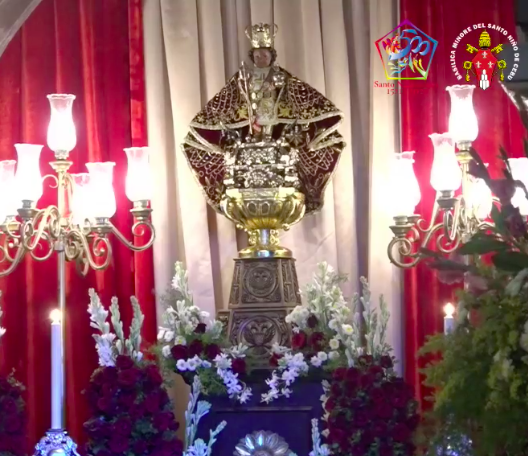
The original image of Snr. Sto. Niño during the ceremonial unveiling of the markers declaring it as a National Cultural Treasure on April 14, 2021. | Photo from BSMN Video
CEBU CITY, Philippines – Cebu makes history again as two of its most precious historical icons were given the highest recognition in terms of heritage value.
The National Historical Commission of the Philippines (NHCP) on Wednesday, April 14, 2021, led the ceremonial unveiling of the markers declaring the Basilica Minore del Sto. Niño de Cebu and the image of Snr. Sto. Niño as National Cultural Treasures.
Present in the event were NHCP chairperson Dr. Rene Escalante, Papal Nuncio to the Philippines Archbishop Charles Brown, Cebu Archbishop Jose Palma, Presidential Assistant to the Visayas Sec. Michael Lloyd Dino, and friars from the Order of Saint Augustine (OSA) who are running the Basilica.
The declaration coincided with the 500th Anniversary of the First Baptism that took place in the country.
“As our contribution in the commemoration, the cultural agencies of our country have decided to declare the Basilica of the Sto. Niño de Cebu as a National Cultural Treasure, one of the highest recognitions the State can give to a particular built heritage,” said Escalante in a speech.
According to the NHCP executive, Wednesday’s new marker for the Basilica is its fourth.
“On the part of National Historical Commission of the Philippines, we have installed three historical markers already, one for the church which was unveiled in 1941, another one for the Magellan’s Cross which was also installed in the same year. The most recent is the marker for the Augustinian order I personally unveiled here three years ago,” Escalante said.
“The Basilica Minore is also a declared National Historical Landmark in 1973, the same status as that of the Barasoain Church in Malolos, Bulacan where the Philippine Republic, the first democracy in Asia, was born in 1899,” he added.
Escalante also said the new recognition granted to the Basilica adds more value to the heritage site.
“These declarations allow the cultural agencies to appropriate funds for its conservation without violating the constitutional provision on the separation of Church and State,” he explained.
The image of Snr. Sto. Niño is regarded as the oldest religious relic in the country.
It was one of the gifts Portuguese explorer Ferdinand Magellan gave to Hara Humamay when the latter was baptized as Queen Juana.
More than 40 years after Magellan’s arrival and his death, a soldier under Miguel Lopez de Legaspi discovered the statue of the Holy Child inside a burning hut when the Spanish conqueror decided to burn down the village upon his arrival in Cebu.
The site of the Basilica, which houses the Sto. Niño, is believed to be the same place where the image of the Child Jesus was found during Legaspi’s expedition.
Cebu celebrates the feast of the Holy Child every January, also known as the Fiesta Senyor. Its secular counterpart is the famous Sinulog Festival.
RELATED STORY: Nat’l Museum to declare Basilica, image of Sto. Niño de Cebu as National Cultural Treasures
/bmjo

